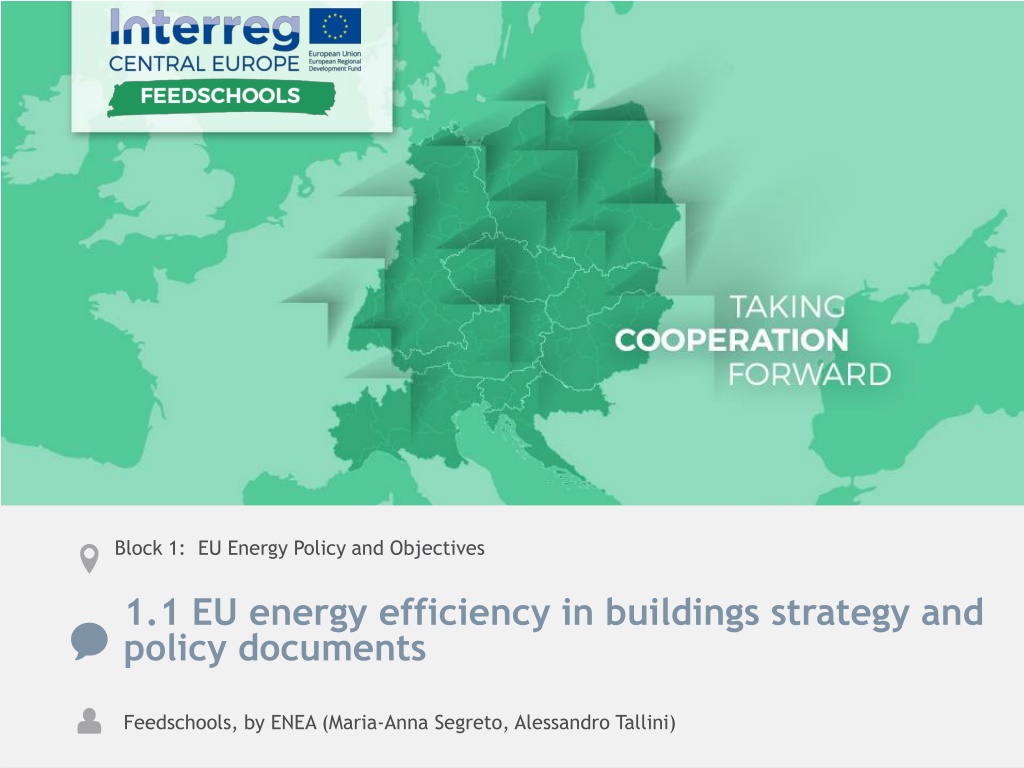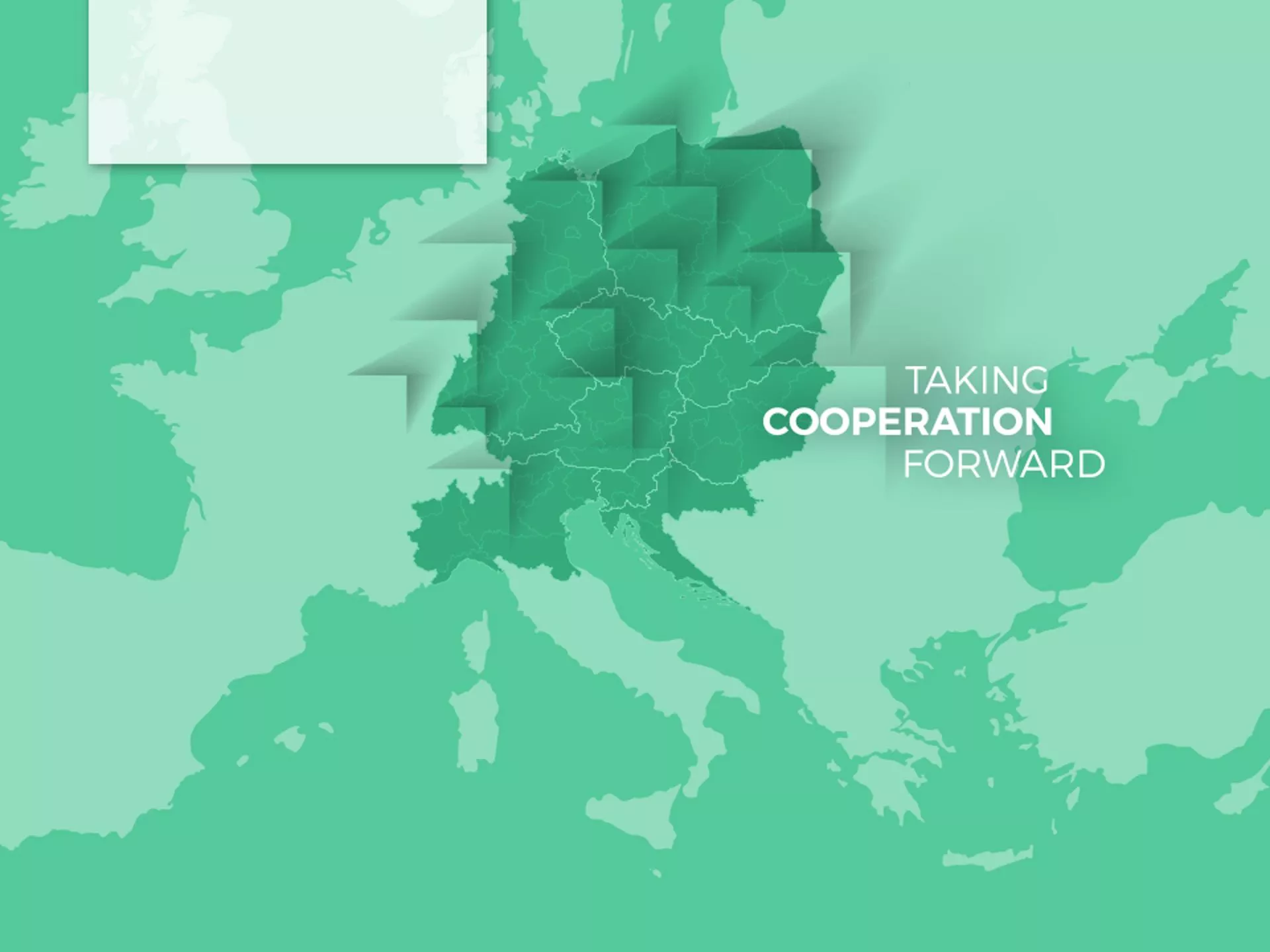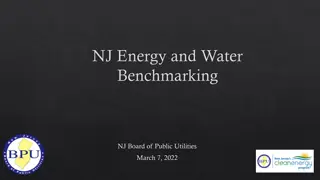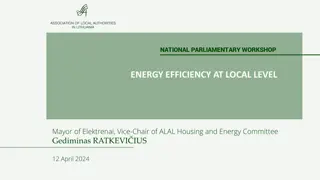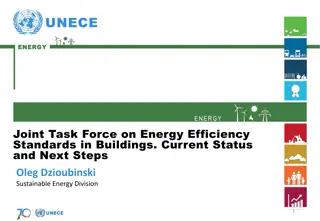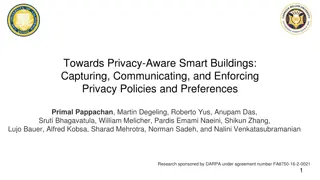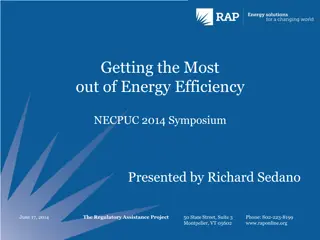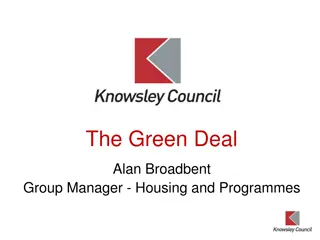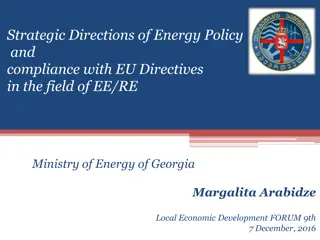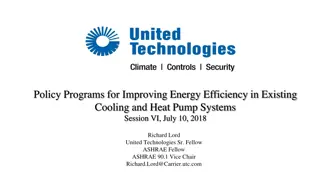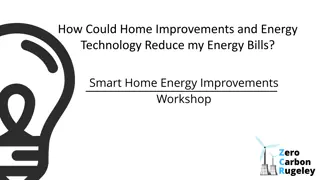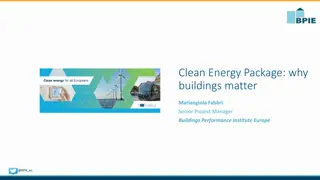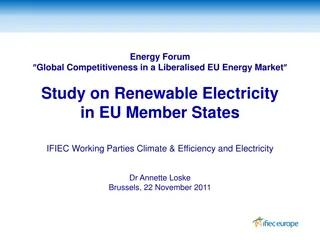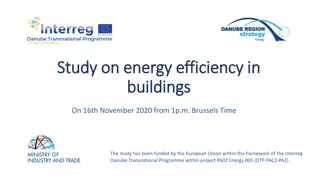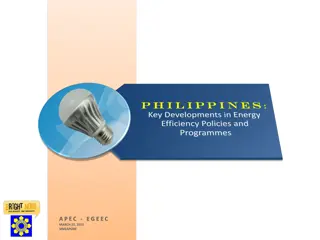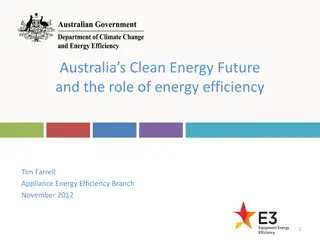European Energy Efficiency Strategies and Policies in Buildings
This training package focuses on EU energy efficiency strategies, particularly in buildings, highlighting the current policy framework, long-term renovation strategies, and the roadmap towards Nearly Zero Energy Buildings. The module aims to equip local authorities with necessary knowledge to implement energy-efficient solutions in schools, emphasizing the crucial role of energy efficiency in decarbonization and sustainability. The content covers key topics such as the European strategy for energy efficiency, current regulatory frameworks, and ambitious strategies supporting energy renovation.
Download Presentation

Please find below an Image/Link to download the presentation.
The content on the website is provided AS IS for your information and personal use only. It may not be sold, licensed, or shared on other websites without obtaining consent from the author. Download presentation by click this link. If you encounter any issues during the download, it is possible that the publisher has removed the file from their server.
E N D
Presentation Transcript
Block 1: EU Energy Policy and Objectives 1.1 EU energy efficiency in buildings strategy and policy documents TAKING COOPERATION FORWARD Feedschools, by ENEA (Maria-Anna Segreto, Alessandro Tallini)
This block is part of a training package developed to provide local authorities with free tuition that may inspire and help them in adopting new technical and financial solutions to implement nearly Zero Energy Building (nZEB) renovation activities in schools. Specify block content: The block is meant to present a concise and comprehensive overview of the European strategies for energy efficiency, and the current European policy framework for energy efficiency with a focus on the energy efficiency of buildings. Level: beginner No special knowledge is needed. TAKING COOPERATION FORWARD
Learning Objective: At the end of this module you will know the current regulatory framework on energy efficiency and its crucial role in the energy union strategy towards decarbonisation, the ambitious strategies to support long-term energy renovation of buildings, the roadmap towards nearly Zero Energy Buildings. 1.1.4 Long-T erm renovations strategies and nZEB buildings strategy 1.1.1 European strategy about Energy Efficiency 1.1.2 EU current framework for energy efficiency 1.1.3 EU policy framework for energy efficiency of buildings 1.1.7 Conclusion 1.1.6 Six pillars for the EU future 1.1.5 Clean Energy for all Europeans Package TAKING COOPERATION FORWARD
1.1.1 Objective 1.1.1 The European strategy for Energy Efficiency In this unit we will deal with the main energy and climate targets set by the European Union for 2030, and the strategic role of energy efficiency in the sustainability and competitiveness of the member states TAKING COOPERATION FORWARD
Reducing energy consumption and energy losses is becoming increasingly important for the EU. In 2007, EU leaders set the target to cut the Union's annual energy consumption by 20% by 2020. In 2018, a new target was set to reduce energy consumption by at least 32.5% by 2030. Energy efficiency measures increasingly recognized as a means not only to ensure sustainable energy supply, reduce greenhouse gas emissions, improve security of supply and reduce import costs, but also to promote the Union's competitiveness. Energy efficiency is therefore a strategic priority of the Energy Union, and the EU promotes the principle of energy efficiency first. The future policy framework for the post- 2030 period is under discussion and new long- term limits (up to 2050) are being considered. are being Source: https://www.buildup.eu/ TAKING COOPERATION FORWARD
1.1.2 Objective 1.1.2 EU current framework for energy efficiency This unit summarises the current EU regulatory framework for energy efficiency, focusing on the relevant European directives. TAKING COOPERATION FORWARD
The current framework for energy efficiency consists of a series of Directives, which are being, or expected to be, revised. The Energy Efficiency Directive (2012/27/EU - EED), which entered into force in December 2012, requires Member States to define indicative national energy efficiency targets to ensure that the EU achieves its main goal of reducing 20% energy consumption by 2020. Member States are free to adopt stricter minimum requirements to promote energy savings. The Directive 2012/27/EU also introduces a number of binding measures to help Member States achieving the goals and establishes legally binding rules for end users and energy suppliers. Additional energy efficiency standards for products and buildings are set by the Ecodesign Directive (2009/125/EC), the Energy Labeling Directive (2010/30/EU), which was (2017/1369/EU), and the Energy Performance of Buildings Directive (2010/31/EU) amended in 2018 (2018/844/EU). updated in 2017 TAKING COOPERATION FORWARD
1.1.3 Objective 1.1.3 EU policy framework for energy efficiency of buildings In this unit we will deal with the key data on the energy consumption of buildings in Europe, the potential savings from the renovation of existing buildings and relevant market opportunities. TAKING COOPERATION FORWARD
Energy consumption by sector in EU-28 Source: Eurostat Buildings are the single largest energy consumer in Europe, they are responsible for approximately 40% of EU energy consumption and 36% of CO2 emissions. At present, about 35% of the EU's buildings are over 50 years old and almost 75% of the building stock is energy inefficient. At the same time, only about 1% of the building stock is renovated each year. Renovation of existing buildings can lead to significant energy savings as it could reduce the EU s total energy consumption by 5-6% and lower CO2 emissions by about 5%. Investments in energy efficiency stimulates the economy, especially the construction industry, which generates about 9% of Europe s GDP and directly accounts for 18 million direct jobs. SMEs in particular would benefit from a boosted renovation market, as they provide more than 70% of the added-value of the EU s building sector. Age of the EU building stock and corresponding average U-value for building envelopes. TAKING COOPERATION FORWARD
1.1.4 Objective 1.1.4 Long-term renovations strategies and nZEB buildings strategy In this unit we will deal with the requirements set out by Energy Performance of Buildings Directive, the long-term renovation strategies for building stocks in the National Energy and Climate Plans and the roadmap towards nZEBs. TAKING COOPERATION FORWARD
All EU Countries must adopt a long-term renovation strategy to support the renovation of their national building stocks so that they develop into highly energy efficient and decarbonised building stocks by 2050. Such a requirement was set out in the EPBD Energy Performance of Buildings Directive. The national strategies will form part of each member country s integrated National Energy and Climate Plans (NECPs) . One EU requirement 28 national implementation rules TAKING COOPERATION FORWARD
The EPBD requires all new buildings to be nearly zero-energy buildings from the end of 2020, while all new public buildings from 2018. nZEB have a very high level of energy performance (in accordance with Annex I of the EPBD). The low amount of energy that these buildings require comes mostly from renewable sources. The EU countries had to draw up and submit nZEB national plans, describing how they intended to increase the number of nZEBs in their respective Country to comply with the EPBD. The Commission closely monitors the progress made by Member States to increase the number of nZEB, including through progress reports and studies. In 2016, the Commission developed the guidelines for the promotion of nZEBs in order to ensure that by 2020, all new buildings were built as nZEBs. Roadmap for nZEBs implementation according to the EPBD recast TAKING COOPERATION FORWARD
1.1.5 Objective In this unit we will deal with the Clean Energy for all Europeans Package, which consist of 8 legislative acts for the implementation of the European Union climate and energy policy 2021-2030; they deal with energy performance in buildings, energy efficiency, renewable energy, electricity market design and the governance structure of the Energy Union. 1.1.5 Clean Energy for all Europeans Package TAKING COOPERATION FORWARD
The package is the EU current energy rulebook and a significant step towards the implementation of the energy union strategy Its main goal is to facilitate the transition away from fossil fuels to cleaner energy sources and fulfill the EU sParis Agreement commitments to reducing greenhouse gas emissions. It will help to decarbonize EU s energy system in line with the European Green Deal objectives. New targets for the EU for 2030 are set. ENERGY EFFICIENCY FIRST! Energy efficiency first Specific measures for the building sector More renewables A better governance of the Energy Union NECPs through a new governance system More rights for consumers A smarter and more efficient electricity market TAKING COOPERATION FORWARD
1.1.6 Objective 1.1.6 Six pillars for the EU future In this unit we will deal with the six pillars of the amended Energy Performance of Buildings Directive Directive (EU) 2018/844 a strengthened directive that help to promote the use of smart technology in buildings, to streamline existing rules and accelerate building renovation. TAKING COOPERATION FORWARD
Energy Performance of Buildings Directive - Main outcomes The EPBD covers a broad range of policies and support measures to help national EU government boost the energy performance of buildings and improve the existing building stock LONG-TERM RENOVATION STRATEGIES EU countries must establish strong LTRS aiming at decarbonising the national building stocks by 2050, with intermediary milestones for 2030, 2040 and 2050. The strategies should contribute to achieving the energy efficiency targets as set in the national energy and climate plans (NECPs) ELECTRO-MOBILITY is supported by introducing minimum requirements for car parks over a certain size and other minimum infrastructure for smaller buildings SMART READINESS, an optional European scheme for rating the smart readiness of buildings is introduced SMART TECHNOLOGIES are by imposing requirements on the installation of building automation and control systems, and on the devices that regulate temperature at room level COST-OPTIMAL MINIMUM ENERGY PERFORMANCE REQUIREMENTS for new buildings, existing buildings undergoing major renovation and the replacement or retrofit of building elements like HVAC, roofs and walls HEALTH AND WELL-BEING OF BUILDING USERS DWELLERS is addressed, for instance by taking into consideration the quality of air and ventilation NZEB all new buildings must be nZEB from 31 Dec. 2020. While all new public buildings needed to be nZEB since 31 Dec. 2018. FINANCIAL MEASURES EU countries must draw up lists of national financial measures to improve the energy efficiency of buildings An EPC must be issued when a building is sold or rented, and inspection schemes for HVAC systems must be established TAKING COOPERATION FORWARD
The 2018/844/EU update provides 6 major pillars on which to base the process of making buildings more efficient. These 6 pillars will guide the EU in the coming years with the aim of a greater energy efficiency in buildings both for new buildings and for refurbishment. TAKING COOPERATION FORWARD
1.1.7 Objective 1.1.7 Conclusion This unit summarises the significant economic, health and safety impacts of energy efficiency measures in buildings, confirms the technical and economic feasibility of nZEB renovation projects but suggests the need to enhance knowledge and skills on NZEB among building professionals. TAKING COOPERATION FORWARD
The new energy policy framework that has been created with the Clean Energy for all Europeans Package provides several opportunities to properly address the issues. Building refurbishment has the biggest available energy saving potential in Europe. Increasing the energy performance of buildings can have a positive impact, not only in economic terms, but also as regards public health and safety by improving indoor climate. Addressing energy efficiency in buildings can bring many co-benefits such as tackling fuel poverty. To achieve enhanced energy performance of buildings we need better technical skills. Training and qualification schemes should ensure that worker qualifications keep pace with the technical complexity of buildings and building components. Several projects with well-designed nZEB have demonstrated that ambition levels like the benchmarks set out in the Commission s recommendation are achievable at reasonable cost, typically being only slightly above the cost-optimal point if well-designed. TAKING COOPERATION FORWARD
Selected resources Clean Energy for All Europeans: Renewable Energies and Energy Efficiency The presentation illustrates energy policy in the EU. It offers a detailed insight into the Commission s proposals for the climate and energy framework. European Green Deal A short presentation to introduce the key points of the Europea Green Deal. Energy efficient buildings European Commission webpage with updated information on laws, EU directives, financial support mechanisms, strategies and studies on the energy efficiency of buildings. Challenges for the buildings sector EU energy policy and post-2020 perspectives Meeting Europe's building renovation challenge Two presentations on the evolution of the EU regulatory framework on energy efficiency. The amended EPBD A short presentation of the amended Energy Performance of Buildings Directive. Annual Report Energy Efficiency 2019 - ENEA The annual report on energy efficiency offers insights on energy efficiency in industry, energy poverty, available financial instruments, energy performance contracting, NZEB buildings, and the main communication and information actions implemented to promote the culture of energy efficiency in Italy. TAKING COOPERATION FORWARD
Maria-Anna Segreto (author and tutor) Researcher and Head of SEI Laboratory of ENEA www.enea.it/en/ mariaanna.segreto@enea.it https://www.facebook.com/eneapaginaufficiale/ https://twitter.com/ENEAOfficial https://www.linkedin.com/company/enea_2 TAKING COOPERATION FORWARD
SELF ASSESSMENT TEST 1.1.1 European strategy for Energy Efficiency The 2030 climate and energy framework includes EU-wide targets and policy objectives for the period from 2021 to 2030. What are the key targets for 2030?: 40% in GHG emissions, 32.5% share for RES, 32.5% improvement in energy efficiency Question 1 A 20% in GHG emissions, 20% share for RES, 20% improvement in energy efficiency B C There are no binding targets Mark the correct answer TAKING COOPERATION FORWARD
SELF ASSESSMENT TEST 1.1.1 European strategy for Energy Efficiency Energy efficiency first is the principle of considering the potential for energy efficiency first in all decision-making related to energy. Consequently, which of the following sentences is to be associated to energy efficiency ? : is a means recognised by the European union to achieve only the reduction of greenhouse gas emissions Question 2 A plays a central role in European policy: the EU has set binding targets of reducing energy consumption through improvements in energy efficiency by 2030 below 30%, relative to a business as usual scenario B can bring multiple benefits, such as enhancing the sustainability of the energy system, supporting strategic objectives for economic and social development, promoting environmental goals and increasing prosperity C Mark the correct answer TAKING COOPERATION FORWARD
SELF ASSESSMENT TEST 1.1.2 EU current framework for energy efficiency the European Commission under the Clean Energy for All Europeans Package is finalising the process of revision of key pieces of energy efficiency legislation including: Question 3 A Energy Efficiency Directive (EED) B Energy Performance of Buildings Directive (EPBD) C EED, EPBD, Labelling and Ecodesign Regulation Mark the correct answer TAKING COOPERATION FORWARD
SELF ASSESSMENT TEST 1.1.2 EU current framework for energy efficiency Question 4 Regarding the EU regulatory framework on energy efficiency: the key element of EED is the new overall target, which goes from 20% improvement in energy efficiency by 2020 to 30% by 2030 A the Ecodesign Directive and Energy Labeling are an effective tools for improving the energy efficiency of the products B It contains specific provisions for the Member States to adopt stricter minimum requirements to promote energy savings C Mark the correct answer TAKING COOPERATION FORWARD
SELF ASSESSMENT TEST 1.1.3 EU policy framework for energy efficiency of buildings Question 5 Renovation of residential buildings in Europe: will generate a low potential for energy savings, as currently around 75% of the EU building stock is already energy efficient A B is the key factor to meet the EU s energy efficiency targets is not considered fundamental because investing in renovation is not regarded as economically viable by the European Union C Mark the correct answer TAKING COOPERATION FORWARD
SELF ASSESSMENT TEST 1.1.3 EU policy framework for energy efficiency of buildings Question 6 Investments in energy efficiency of buildings: A can stimulates the economy, especially the construction industry should be carefully assessed because collectively, buildings in the EU are responsible for only 20% of energy consumption and 5-6% of GHG emissions, which mainly stem from construction, usage, renovation and demolition B is only interesting for large companies, which can benefit from a boosted renovation market C Mark the correct answer TAKING COOPERATION FORWARD
SELF ASSESSMENT TEST 1.1.4 Long-Term renovations strategies and nZEB buildings strategy Question 7 nearly Zero Energy Building : means a buildings that has a very high energy performance in accordance with the Energy Performance of Buildings Directive A B is not one of the best options for increasing energy savings in Europe. is too ambitious a standard compared to the current construction criteria in the building industry C Mark the correct answer TAKING COOPERATION FORWARD
SELF ASSESSMENT TEST 1.1.4 Long-Term renovations strategies and nZEB buildings strategy Question 8 With regard to nZEB: the EU has set a target for all new buildings to be nearly zero-energy (nZEB) by 2030. A a nearly Zero-Energy Building (nZEB) is a building that has a very high energy performance. However, it is not necessary to use renewable sources to cover the energy needs of nZEB building B C all new public buildings were to be nZEB as early as 2019 Mark the correct answer TAKING COOPERATION FORWARD
SELF ASSESSMENT TEST 1.1.5 Long-Term renovations strategies and the nZEB buildings strategy Does the amended EPBD Directive fit within the overall Clean Energy for All Europeans Package? Does Question 9 EPBD is important to build a resilient Energy Union and a forward- looking climate change policy by putting energy efficiency first A the building sector has a good potential to contribute to a carbon-neutral and competitive economy but this potential it is difficult to exploit B C the EPBD is not fully in line with the Clean Energy Package Mark the correct answer TAKING COOPERATION FORWARD
SELF ASSESSMENT TEST 1.1.5 Long-Term renovations strategies and nZEB buildings strategy Question 10 The Clean Energy for All Europeans Package: sets new targets for the EU by 2020, including a binding renewable energy target of at least 32% A is a comprehensive set of legislation that defines European climate and energy policy for 2020 and beyond, composed of eight different pieces of legislation aimed at accelerating the energy transition in Europe B according to the European Union, will not generate significant impacts on the GDP, the economy or the employment sector C Mark the correct answer TAKING COOPERATION FORWARD
SELF ASSESSMENT TEST 1.1.6 Six pillars for the EU future Question 11 By renovating an old energy-inefficient building: a reduction of utility bills and an increase of the ability to keep home adequately warm can be expected A the improvement of the health of the tenants by reducing illnesses and deaths caused by a poor indoor climate, and dampness is not evident B the revised EPBD directive does not support the uptake of technical innovation in the building sector C Mark the correct answer TAKING COOPERATION FORWARD
SELF ASSESSMENT TEST 1.1.6 Six pillars for the EU future Strengthen monitoring and compliance: the EPBD does not cover the following policies and support measures: Question 12 A EPBD does not actually cover quality of works B long-term national strategies C national financial measures Mark the correct answer TAKING COOPERATION FORWARD
SELF ASSESSMENT TEST 1.1.7 Conclusion Question 13 Increasing the energy performance of a building: Is in general important: it is possible to realize an nZEB with very high energy performance, but only at considerable construction costs A has no significant impacts on public health and safety as it does not improve the indoor climate B therefore has a key role to play in achieving the ambitious goal of carbon-neutrality by 2050, set out in the European Green Deal C Mark the correct answer TAKING COOPERATION FORWARD
SELF ASSESSMENT TEST 1.1.7 Conclusion Addressing energy efficiency in buildings can help to trigger multiple benefits. With reference to energy (or fuel) poverty): Question 14 despite good intentions, the EPBD will not succeed in stimulating the transition to vigorous energy renovation programmes for fuel-poor homes A It allows you to tackle fuel poverty: the EPBD can actively contribute to a more effective policy landscape to eliminate fuel poverty. B C energy poverty is not clearly linked to buildings Mark the correct answer TAKING COOPERATION FORWARD
SELF ASSESSMENT TEST RESULTS 1.1.1 European strategy about Energy Efficiency The 2030 climate and energy framework includes EU-wide targets and policy objectives for the period from 2021 to 2030. Key targets for 2030: Question 1 40% in GHG emissions, 32.5% share for RES, 32.5% improvement in energy efficiency A 20% in GHG emissions, 20% share for RES, 20% improvement in energy efficiency B C the targets are not binding Correct answer is green TAKING COOPERATION FORWARD
SELF ASSESSMENT TEST RESULTS 1.1.1 European strategy about Energy Efficiency Energy efficiency first is the principle of considering the potential for energy efficiency first in all decision-making related to energy. Energy efficiency: Question 2 is a means recognised by the European union to achieve only the reduction of greenhouse gas emissions A plays a central role in European policy: the EU has set binding targets of reducing energy consumption through improvements in energy efficiency by 2030 below 30%, relative to a business as usual scenario B can bring multiple benefits, such as enhancing the sustainability of the energy system, supporting strategic objectives for economic and social development, promoting environmental goals and increasing prosperity C Correct answer is green TAKING COOPERATION FORWARD
SELF ASSESSMENT TEST RESULTS 1.1.2 EU current framework for energy efficiency the European Commission legislation under the Clean Energy for All Europeans Package is finalising the process of revision of key pieces of energy efficiency including Question 3 A Energy Efficiency Directive (EED) B Energy Performance of Buildings Directive (EPBD) C EED, EPBD, Labelling and Ecodesign Regulation Correct answer is green TAKING COOPERATION FORWARD
SELF ASSESSMENT TEST RESULTS 1.1.2 EU current framework for energy efficiency Regarding the EU regulatory framework on energy efficiency: Question 4 the key element of EED is the new overall target, which goes from 20% improvement in energy efficiency by 2020 to 30% by 2030 A the Ecodesign Directive and Energy Labeling are an effective tool for improving the energy efficiency of the products B according to the provisions of the Member States they must adopt stricter minimum requirements to promote energy savings C Correct answer is green TAKING COOPERATION FORWARD
SELF ASSESSMENT TEST RESULTS 1.1.3 EU policy framework for energy efficiency of buildings Question 5 Renovation of residential buildings in Europe will generate a low potential for energy savings as currently around 75% of the EU building stock is energy efficient A B is the key factor to meet the EU s energy efficiency targets is not considered fundamental because investing in renovation is not considered economically viable by the European Union C Correct answer is green TAKING COOPERATION FORWARD
SELF ASSESSMENT TEST RESULTS 1.1.3 EU policy framework for energy efficiency of buildings Question 6 Investments in energy efficiency of buildings: A can stimulates the economy, especially the construction industry should be carefully assessed because collectively buildings in the EU are responsible for only 20% of energy consumption and 5-6% of GHG emissions, which mainly stem from construction, usage, renovation and demolition B is only interesting for large companies can benefit from a boosted renovation market C Correct answer is green TAKING COOPERATION FORWARD
SELF ASSESSMENT TEST RESULTS 1.1.4 Long-Term renovations strategies and nZEB buildings strategy Question 7 nearly Zero Energy Building means a buildings that has a very high energy performance in accordance with Energy Performance of Buildings Directive A B is not one of the best options for increasing energy savings in Europe. is too ambitious a standard compared to the current construction criteria in the building industry C Correct answer is green TAKING COOPERATION FORWARD
SELF ASSESSMENT TEST RESULTS 1.1.4 Long-Term renovations strategies and nZEB buildings strategy Question 8 With regard to nZEB: the EU has set a target for all new buildings to be nearly zero-energy (nZEB) by 2030 A a nearly Zero-Energy Building (nZEB) is a building that has a very high energy performance. However, it is not necessary to use renewable sources to cover the energy needs of an nZEB building B C all new public buildings were to be nZEB as early as 2019 Correct answer is green TAKING COOPERATION FORWARD
SELF ASSESSMENT TEST RESULTS 1.1.5 Long-Term renovations strategies and nZEB buildings strategy The amended EPBD Directive fit within the overall Clean Energy for All Europeans Package? Question 9 EPBD is important to build a resilient Energy Union and a forward- looking climate change policy putting energy efficiency first A the building sector has a good potential to contribute to a carbon-neutral and competitive economy but this potential it is difficult to exploit B C the EPBD is not fully in line with the Clean Energy Package Correct answer is green TAKING COOPERATION FORWARD
SELF ASSESSMENT TEST RESULTS 1.1.5 Long-Term renovations strategies and nZEB buildings strategy Question 10 Clean Energy for All Europeans Package: sets new targets for the EU by 2020, including a binding renewable energy target of at least 32% A is a comprehensive set of legislation that defines European climate and energy policy for 2020 and beyond, composed of eight different pieces of legislation aimed at accelerating the energy transition in Europe B according to the European Union, will not generate significant impacts on GDP, economy and jobs created C Correct answer is green TAKING COOPERATION FORWARD
SELF ASSESSMENT TEST RESULTS 1.1.6 Six pillars for the EU future Question 11 By renovating an old energy-inefficient building: a reduction of utility bills and an increase of the ability to keep home adequately warm can be expected A the improvement of the health of the tenants by reducing illnesses and deaths caused by a poor indoor climate and the presence of leaks and dampness is not evident B The revised EPBD directive does not support the uptake of technical innovation in the building sector C Correct answer is green TAKING COOPERATION FORWARD
SELF ASSESSMENT TEST RESULTS 1.1.6 Six pillars for the EU future Strengthen monitoring and compliance: the EPBD does not cover the following policies and support measures: Question 12 EPBD does not actually cover quality of works while development of skills is crucial to meet building requirements and to secure a high performance of products and technologies in the long-term A B long-term national strategies C national financial measures Correct answer is green TAKING COOPERATION FORWARD
SELF ASSESSMENT TEST RESULTS 1.1.7 Conclusion Question 13 Increasing the energy performance of a building in general is important: it is possible to realize an nZEB with very high energy performance, but only at considerable construction costs A has no significant impacts on public health and safety as it does not improve the indoor climate B therefore has a key role to play in achieving the ambitious goal of carbon-neutrality by 2050, set out in the European Green Deal C Correct answer is green TAKING COOPERATION FORWARD
SELF ASSESSMENT TEST RESULTS 1.1.7 Conclusion Addressing energy efficiency in buildings can help to trigger multiple benefits. With reference to energy (or fuel) poverty): Question 14 despite good intentions, the EPBD will not succeed in stimulating the transition to vigorous energy renovation programmes for fuel-poor homes A allows you to tackle fuel poverty: the EPBD can actively contribute to a more effective policy landscape to eliminate fuel poverty. B C energy poverty is not clearly linked to buildings Correct answer is green TAKING COOPERATION FORWARD
